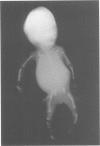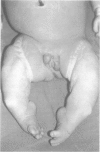Abstract
Campomelic dysplasia (CMD) is a rare skeletal disorder that is usually lethal. It is characterised by bowing of the lower limbs, severe respiratory distress, and many of the chromosomal (XY) males show sex reversal. Because of a number of reports of familial campomelic dysplasia it is considered to be inherited in an autosomal recessive manner. In this study, details of 36 patients with campomelic dysplasia were collected from genetic centres, radiologists, and pathologists in the United Kingdom. The chromosomal sex ratio was approximately 1:1. There was a preponderance of phenotypic females owing to sex reversal. Three quarters of the chromosomal males were sex reversed or had ambiguous genitalia. Three cases are still alive, two with chromosomal rearrangements involving chromosome 17q. The majority of the others died in the neonatal period. The 36 index cases had 41 sibs of whom only two were affected. Formal segregation analysis gave a segregation ratio of 0.05 (95% CI approximately 0.00 to 0.11). This excludes an autosomal recessive mode of inheritance. The data suggest a sporadic, autosomal dominant mode of inheritance. Patients with a chromosomal rearrangement involving 17q (q23.3-q25.1) show a milder phenotype. The molecular mechanism for the difference is still unknown.
Full text
PDF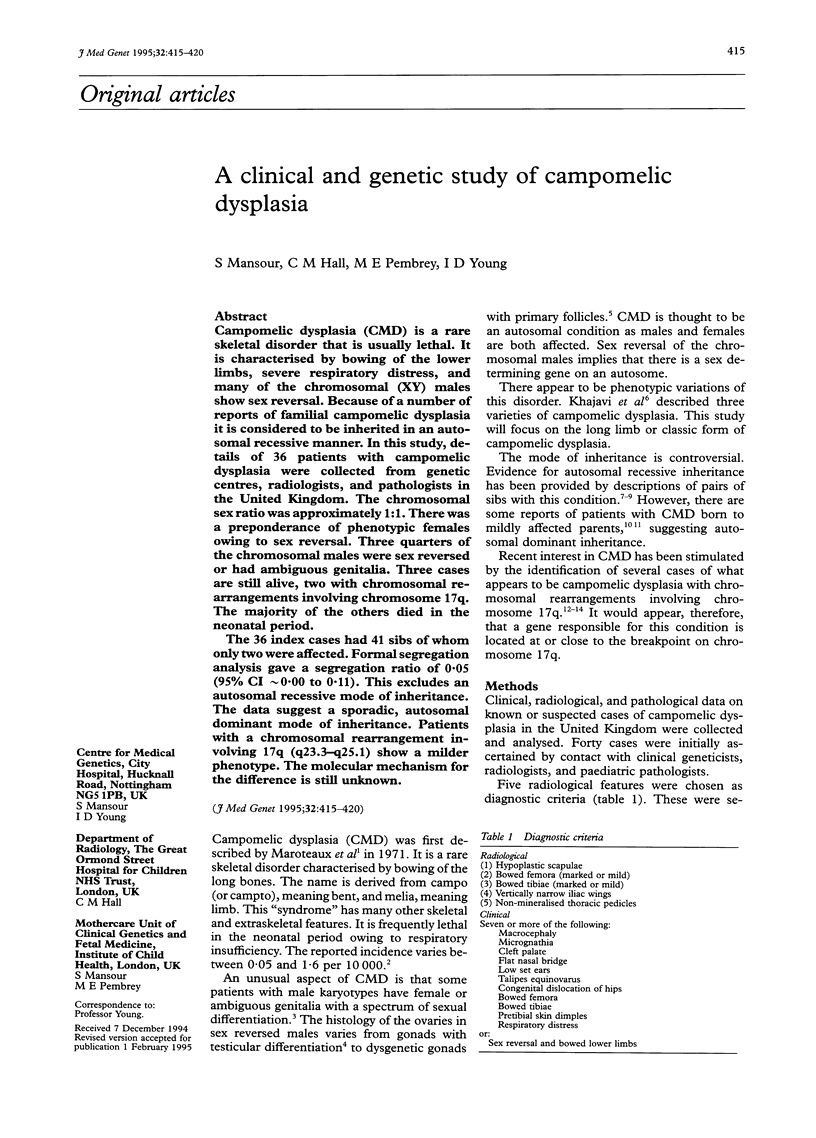
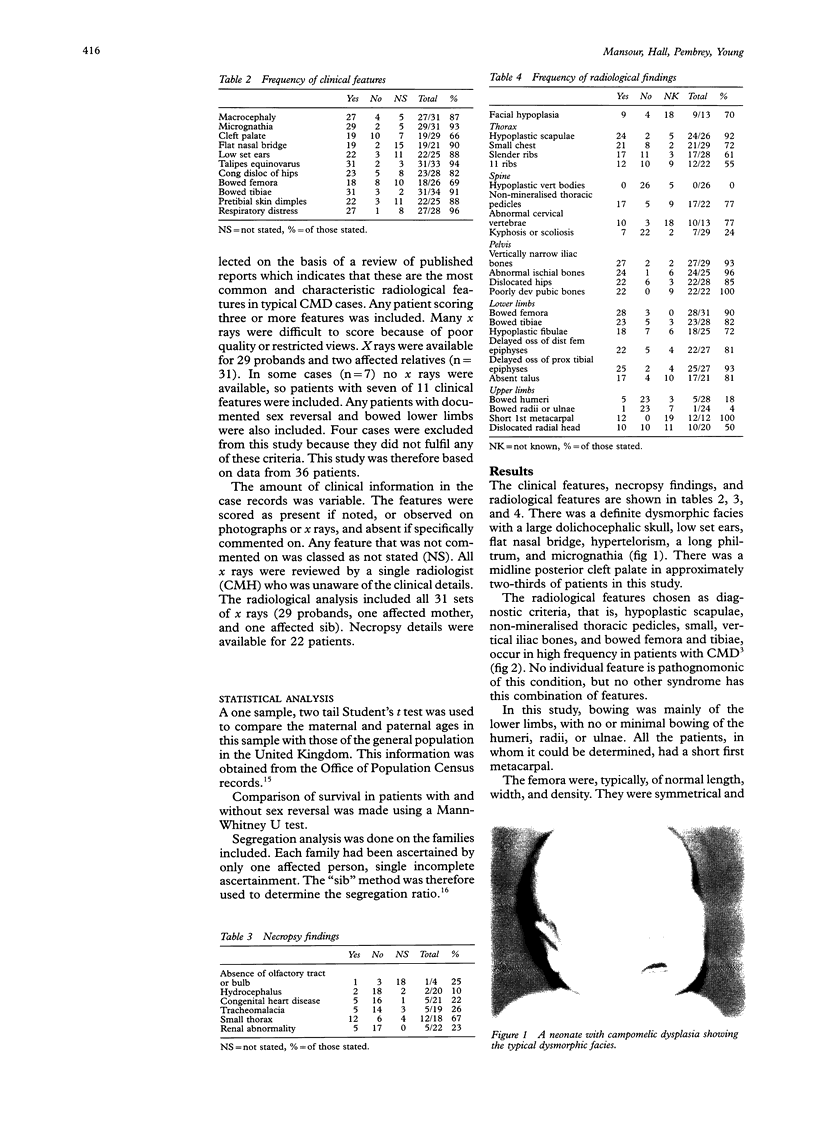
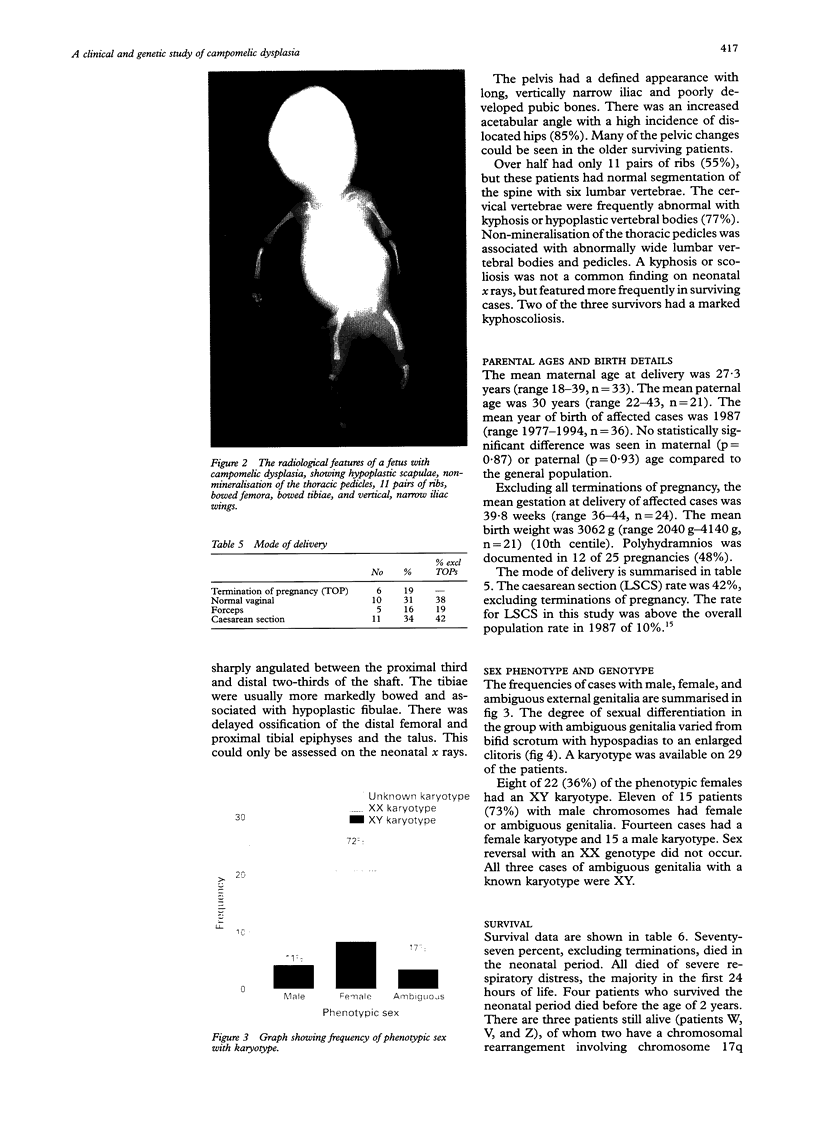
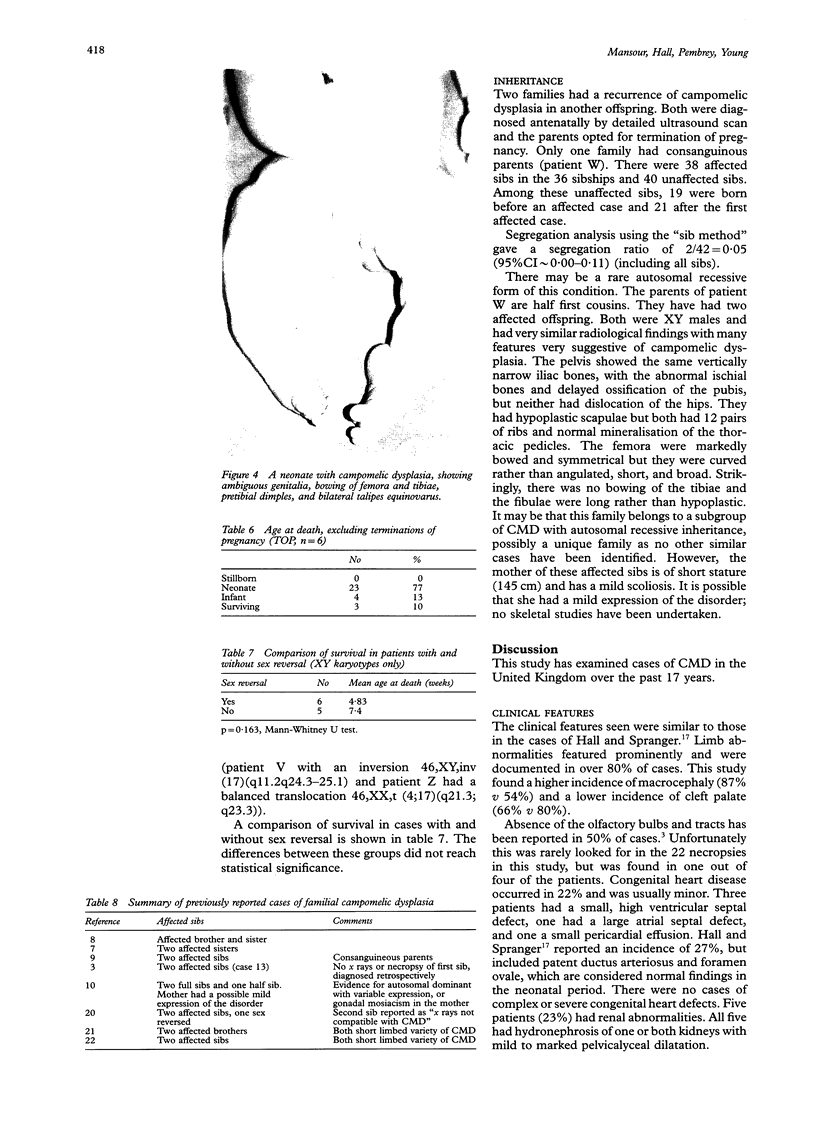
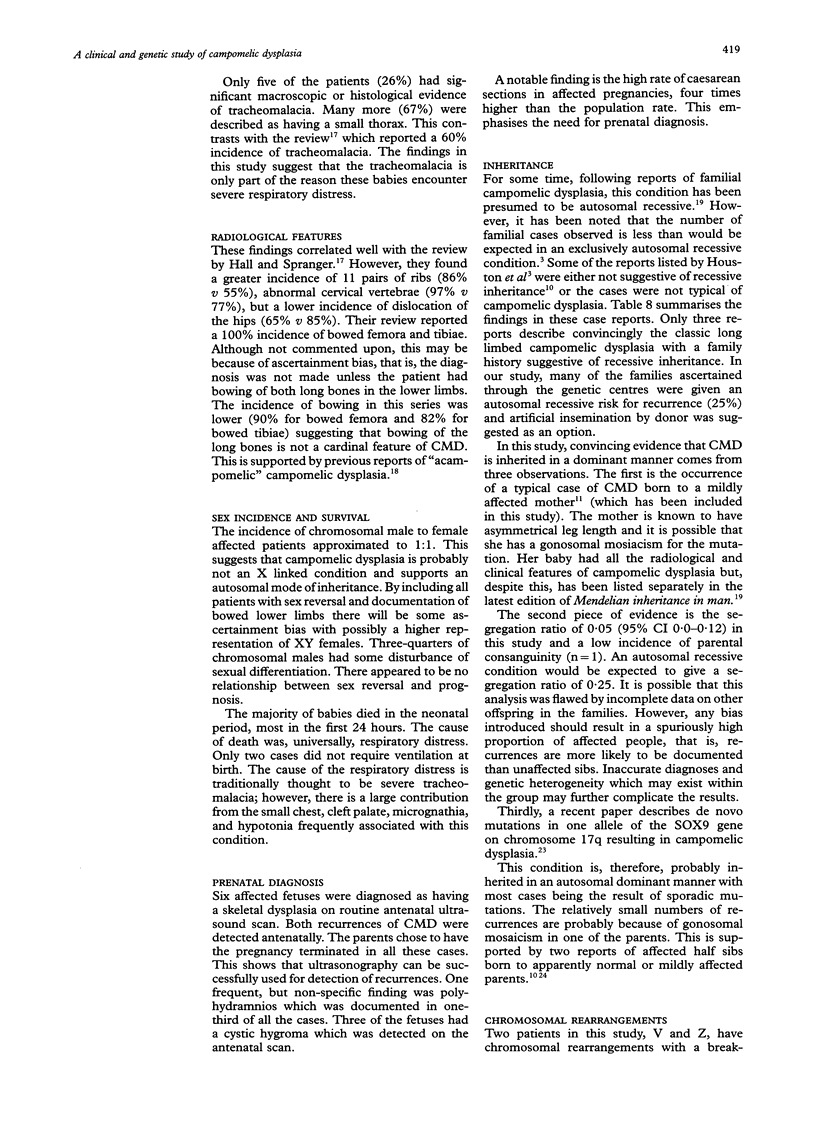

Images in this article
Selected References
These references are in PubMed. This may not be the complete list of references from this article.
- Bricarelli F. D., Fraccaro M., Lindsten J., Müller U., Baggio P., Carbone L. D., Hjerpe A., Lindgren F., Mayerová A., Ringertz H. Sex-reversed XY females with campomelic dysplasia are H-Y negative. Hum Genet. 1981;57(1):15–22. doi: 10.1007/BF00271160. [DOI] [PubMed] [Google Scholar]
- Cooke C. T., Mulcahy M. T., Cullity G. J., Watson M., Srague P. Campomelic dysplasia with sex reversal: morphological and cytogenetic studies of a case. Pathology. 1985 Jul;17(3):526–529. doi: 10.3109/00313028509105515. [DOI] [PubMed] [Google Scholar]
- Foster J. W., Dominguez-Steglich M. A., Guioli S., Kwok C., Weller P. A., Stevanović M., Weissenbach J., Mansour S., Young I. D., Goodfellow P. N. Campomelic dysplasia and autosomal sex reversal caused by mutations in an SRY-related gene. Nature. 1994 Dec 8;372(6506):525–530. doi: 10.1038/372525a0. [DOI] [PubMed] [Google Scholar]
- Friedrich U., Schaefer E., Meinecke P. Campomelic dysplasia without overt campomelia. Clin Dysmorphol. 1992 Jul;1(3):172–178. [PubMed] [Google Scholar]
- Fryns J. P., van den Berghe K., van Assche A., van den Berghe H. Prenatal diagnosis of campomelic dwarfism. Clin Genet. 1981 Mar;19(3):199–201. doi: 10.1111/j.1399-0004.1981.tb00696.x. [DOI] [PubMed] [Google Scholar]
- Gardner L. I., Assemany S. R., Neu R. L. 46, XY female: anti-androgenic effect of oral contraceptive? Lancet. 1970 Sep 26;2(7674):667–668. doi: 10.1016/s0140-6736(70)91441-8. [DOI] [PubMed] [Google Scholar]
- Hall B. D., Spranger J. W. Campomelic dysplasia. Further elucidation of a distinct entity. Am J Dis Child. 1980 Mar;134(3):285–289. doi: 10.1001/archpedi.1980.02130150039010. [DOI] [PubMed] [Google Scholar]
- Houston C. S., Opitz J. M., Spranger J. W., Macpherson R. I., Reed M. H., Gilbert E. F., Herrmann J., Schinzel A. The campomelic syndrome: review, report of 17 cases, and follow-up on the currently 17-year-old boy first reported by Maroteaux et al in 1971. Am J Med Genet. 1983 May;15(1):3–28. doi: 10.1002/ajmg.1320150103. [DOI] [PubMed] [Google Scholar]
- Khajavi A., Lachman R. S., Rimoin D. L., Schimke R. N., Dorst J. P., Ebbin A. J., Handmaker S., Perreault G. Heterogeneity in the campomelic syndromes: long and short bone varieties. Birth Defects Orig Artic Ser. 1976;12(6):93–100. [PubMed] [Google Scholar]
- Lynch S. A., Gaunt M. L., Minford A. M. Campomelic dysplasia: evidence of autosomal dominant inheritance. J Med Genet. 1993 Aug;30(8):683–686. doi: 10.1136/jmg.30.8.683. [DOI] [PMC free article] [PubMed] [Google Scholar]
- Maroteaux P., Spranger J., Opitz J. M., Kucera J., Lowry R. B., Schimke R. N., Kagan S. M. Le syndrome campomélique. Presse Med. 1971 May 22;79(25):1157–1162. [PubMed] [Google Scholar]
- Mellows H. J., Pryse-Davies J., Bennett M. J., Carter C. O. The camptomelic syndrome in two female siblings. Clin Genet. 1980 Aug;18(2):137–141. doi: 10.1111/j.1399-0004.1980.tb01024.x. [DOI] [PubMed] [Google Scholar]
- Normann E. K., Pedersen J. C., Stiris G., van der Hagen C. B. Campomelic dysplasia--an underdiagnosed condition? Eur J Pediatr. 1993 Apr;152(4):331–333. doi: 10.1007/BF01956747. [DOI] [PubMed] [Google Scholar]
- Shafai T. Letter: Camptomelic syndrome in siblings. J Pediatr. 1976 Sep;89(3):512–513. doi: 10.1016/s0022-3476(76)80568-9. [DOI] [PubMed] [Google Scholar]
- Stüve A., Wiedemann H. R. Congenital bowing of the long bones in two sisters. Lancet. 1971 Aug 28;2(7722):495–495. doi: 10.1016/s0140-6736(71)92666-3. [DOI] [PubMed] [Google Scholar]
- Thurmon T. F., DeFraites E. B., Anderson E. E. Familial camptomelic dwarfism. J Pediatr. 1973 Nov;83(5):841–843. doi: 10.1016/s0022-3476(73)80384-1. [DOI] [PubMed] [Google Scholar]
- Tommerup N., Schempp W., Meinecke P., Pedersen S., Bolund L., Brandt C., Goodpasture C., Guldberg P., Held K. R., Reinwein H. Assignment of an autosomal sex reversal locus (SRA1) and campomelic dysplasia (CMPD1) to 17q24.3-q25.1. Nat Genet. 1993 Jun;4(2):170–174. doi: 10.1038/ng0693-170. [DOI] [PubMed] [Google Scholar]
- Winter R., Rosenkranz W., Hofmann H., Zierler H., Becker H., Borkenstein M. Prenatal diagnosis of campomelic dysplasia by ultrasonography. Prenat Diagn. 1985 Jan-Feb;5(1):1–8. doi: 10.1002/pd.1970050102. [DOI] [PubMed] [Google Scholar]
- Young I. D., Zuccollo J. M., Maltby E. L., Broderick N. J. Campomelic dysplasia associated with a de novo 2q;17q reciprocal translocation. J Med Genet. 1992 Apr;29(4):251–252. doi: 10.1136/jmg.29.4.251. [DOI] [PMC free article] [PubMed] [Google Scholar]




